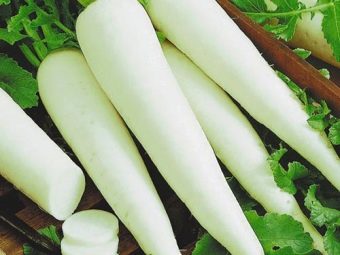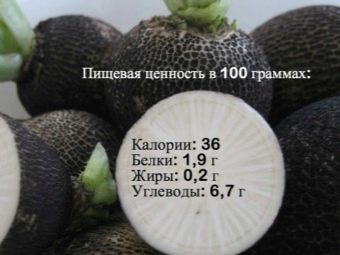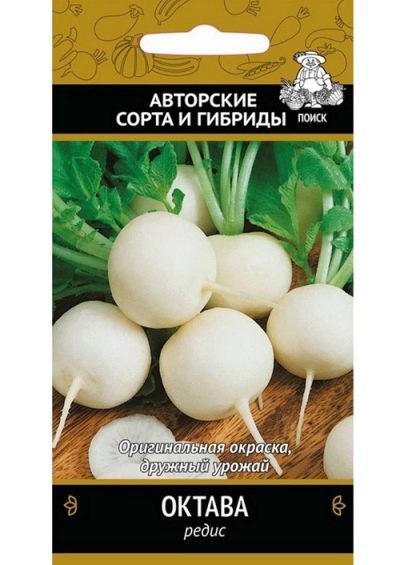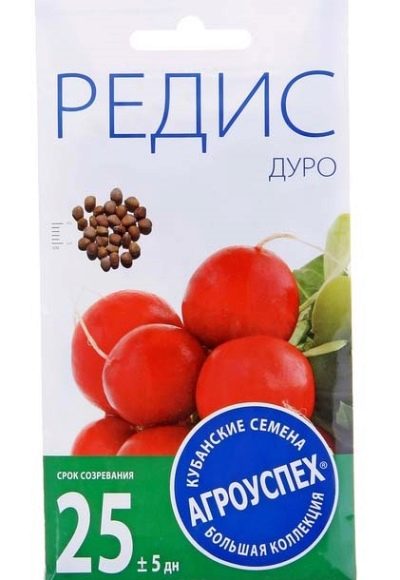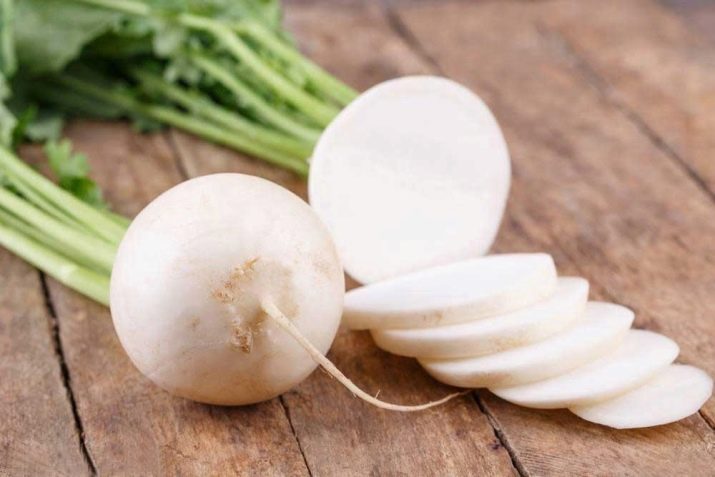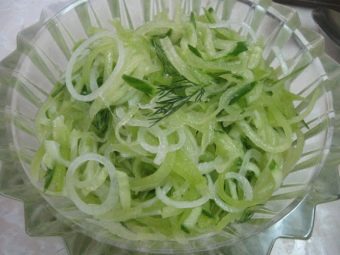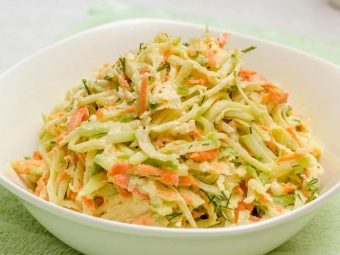Radish: properties, types and uses

Vegetables are the basis of proper diet. They provide the body with vitamins, minerals, acids, oils, carbohydrates and protein.Of these, you can make a large number of tasty and healthy dishes.
There are about 200 vegetable crops in the world, but we constantly eat no more than 20 species. Some vegetables are difficult to grow in the Russian climate, and some are undeservedly forgotten. One of these vegetables - ordinary radish.
Medicinal properties, types and use of this plant in cooking were well known to our ancestors. Radish is a source of nutrients and an unusual ingredient in familiar dishes, so it must again take its rightful place on the dining table.
What it is?
Radish is an edible representative of an annual and biennial plant of the cabbage genus. Her closest relatives are all kinds of cabbage (cauliflower, Chinese, white cabbage, and others), turnips, broccoli, rutabaga, arugula. Many medicinal herbs belong to this family and have similar beneficial properties. The vegetable got its name from the word “Radix”. In Latin, it means "root." This name immediately indicates that it is not the fruits or seeds of the plant that should be eaten, but its underground part.
The radish root crop is large, “fleshy”, resembles a turnip or a spindle in shape (in each class the fruit looks different). For the Russian climate, a vegetable weighing 200 to 2000 grams is considered the norm. In Japan, radish reaches record sizes - up to 30 kg. The longest root crops are also grown there - up to 2 meters.
The aboveground part of the plant is a branched straight stalk and lyre leaves. When the plant matures, white or pale pink tassels of flowers appear. Petals often have purple streaks. Later spherical brownish seeds appear in the pods.
The root crop is considered ripe when it is “poured” and has acquired a rich color. The color of the peel depends on the variety of radish. It can be white, dark green, black, deep pink, violet. The color is uniform, but there can be transitions from light to dark and vice versa.
This vegetable culture is unpretentious and prolific. It can be planted in early spring, the very first of the vegetables. She does not need a lot of light and heat. It gives a bountiful harvest in cold weather down to -3, and in hot weather. The only condition for plant growth is a sufficient amount of water. Ripe root vegetable is 90% water, so radish is moisture-loving.
Radish ordinary is not afraid of garden pests. She does not need expensive fertilizers and special protection. Ash and tincture of herbs are suitable for feeding.
With early spring sowing in June you can collect radish for cooking. At the same time, it is recommended to plant a second batch of seeds, so that they yield a crop by early autumn. These fruits are stored. They are experiencing a great winter in the cellar or on the balcony, in wooden boxes.
Boxes should be put in a dark, cool place, and root crops inside should be poured with wet sand, so that they do not dry up for many months outside the soil. Top box, too, need to fall asleep with sand and do not close. This is the best way to stock up on vitamins for the whole winter.
There are legends about useful properties and values of radish. It was used in cooking and medicine by the Greeks, Egyptians and Romans. In Egypt, it fed those who were engaged in heavy physical labor, and in Greece, they literally valued their weight in gold.
Due to its beneficial properties, the radish has been honored in the scientific works of Hippocrates. Miraculous vegetable recommended to take in diseases of the kidneys, stomach, lungs. It was considered useful for pregnant and lactating mothers, because it contributed to the production of breast milk in the right quantities. For this, radish was forgiven for its specific taste.
In Russia, because of the bitter taste, the vegetable received an unflattering description - “horseradish is not sweeter”. Despite this, it was grown in large quantities and used in various dishes and medicines, because “radish of evil, yes to all is sweet.” She feeds and heals, and replaces some of the care products for the beauty of hair and skin.
What is different from turnips?
Radish is often confused with turnips.And it is not surprising, because both of these vegetables belong to the same cruciferous (cabbage) family. However, they have five major differences.
- The shape of the root. In turnip fruit characteristic shape. Their upper part is flatter, and the narrowing to the tip is smooth. The radish has a round shape, elongated or spindle-shaped.
- The color of the fruit. The classic and most common variety of turnip, as in the fairy tale - light yellow or golden. There are fruits and other flowers, but in our area they are not common. The common radish has a black peel, less commonly green, white or pink.
- Taste qualities. Radish "vigorous", bitter, with a characteristic taste. Turnip flesh, on the contrary, is soft and slightly sweet. There is no need to get used to her taste.
- Beneficial features. Both turnip and radish contain a number of nutrients and vitamins, but their content varies. In radish, more water, and in turnips fiber. Turnip twice the radish by the number of kilocalories per 100 grams. It also contains a high content of vitamin C (more than orange and lemon) and sulforaphane. The substance sulforaphane in sufficient quantities is found only in turnips, broccoli, kohlrabi and cauliflower. It has a powerful anti-oncological action. And radish contains other anti-cancer substances - indoles. Turnip is used in the treatment of throat, kidneys, joints, while radish is more useful for problems with the liver, lungs, and immunity.
- Use in cooking. Black radish in its pure form is not recommended in large quantities. It is appropriate as an ingredient in various dishes. It goes well with baked vegetables, grated with carrots and apples, in marinade, with honey, sugar and other combinations. Without the risk of heartburn, only some types of radish, white radish and Margillan radish can be eaten raw.
Turnip does not irritate the body, so it is eaten raw with oil and salt. In addition, it is boiled, baked, replaced with mashed potatoes.
Nutritional value and calorie
The use of products is evaluated by their ability to give a person energy, saturate it and enrich the body with useful substances. Nutritional value is a combination of product properties that provides physical activity and replenishes the daily supply of nutrients. The main sources of benefits for humans are proteins, fats and carbohydrates. And complement their chemical elements.
Energy value varies in calories. The fewer calories in 100 grams of the product, and the richer at the same time its composition of proteins, useful carbohydrates, vitamins, water and fiber, the more valuable such product in the daily diet.
Each person has an individual rate of calories per day. The lower the calorie content and the higher the usefulness of the foods we eat, the greater the volume of food that can be eaten without harm to the body and health.
Radish in this regard is in the upper ranks of the food table. With the most rich chemical composition, it has a minimum calorie content. In red and white varieties - 16-21 kcal per 100 grams. In black and green - from 20 to 36 kcal. Due to the high content of water and dietary fiber, the pulp of the root is very nourishing. Due to such a low caloric content, different types of radish are present in the diet menu.
Varieties
The genus cabbage prolific and diverse. There are several dozens of types of edible radish alone. In addition to them, there is also radish fodder (for livestock), and technical (weed varieties that are processed into silage).
Root crops for culinary and medical purposes are grown in agriculture, orchards and vegetable gardens. For silage fits the usual field radish, which is not sown purposefully. This is a weed plant.
In the gardens of our compatriots there are up to 8 species of radish, but only 5 basic ones:
- sowing (radish);
- winter black (ordinary);
- winter white;
- Chinese (Margellan) green;
- Japanese (daikon).
Sowing
Radish and common radish - plants of the same species. They are largely identical: the appearance, color of leaves, the shape and color of the root. The flesh of both vegetables is juicy, firm and crispy.
There are few fundamental differences between plants. The first of these is obvious - the size of the radish is much smaller than the radish root crops. They are only 3-5 cm in diameter and weigh no more than 50 grams. The second is manifested only when the sample is “on the tooth” - the radish is more tender to taste.
It is characterized by the sharpness and bitter notes characteristic of this plant, but they are less pronounced.
Significantly different color of the root. In addition to the common white-pink color, the skin color of the radish can be white, red, gray, brown, yellow or purple. The color of the pulp is different in different varieties.
Like radish, radish unpretentious, but loves moisture. The plant gives the first harvest already in the beginning of June or 34-40 days after sowing the seeds.
In a radish, everything is valuable - a root crop, peel, juice and tops. All its parts are useful to eat. They are tasty, nourishing, nutritious and help with various ailments, be it headache or sciatica.
The best varieties of radishes for open and closed ground.
- "Sora". Dutch variety for early sowing. At temperatures up to -3, you can land in open and closed ground, and after 35 days get the first crop for salad. The fruits of this variety are round, similar to black radish in shape, but weigh only 25-30 g. The rind is dull red, and underneath is juicy white flesh.
- Celeste. An early maturing plant with a shiny fuchsia skin. It is her most often planted by gardeners and sell grandmothers in vegetable markets. "Celeste" is large, tasty, matures in just 25 days.
- "18 days". Sort with a talking name. The first fruits appear in less than 3 weeks. They are cylindrical, pink, with juicy and sweetish pulp. Typical for radish astringency is absent.
- "Octave". Hardy and prolific variety for beds outside greenhouses and greenhouses. Round fruits with long tails weigh 25-30 g, have white skin and dense white flesh. The acuity is poorly expressed, therefore the variety is suitable for any kind of dishes and fresh use.
- "Duro". Variety for growing all year round. Gives a harvest in the open field, in the greenhouse and even in the tub on the balcony. The roots of this plant differ in large size and weight - up to 5 cm in diameter and 35-50 g. The skin of the fruit is thin and delicate, and the flesh is slightly mild.
- "French breakfast". Unpretentious early-ripening plant, well tolerated in the neighborhood with other vegetable crops. It can be planted in any type of soil in early spring. After 25 days, the first batch for the salad will be ready. “French breakfast” differs from other varieties in an unusual form. Fruits resemble fingers or gherkins. Under the white-pink skin, juicy and crunchy flesh, and above the fruit - tender lettuce foliage.
- "Icicle". This variety of radish is actually a reduced version of daikon. The elongated white roots of small size have a thin white skin and dense pulp with bitterness. Vegetable is good in salads and fresh.
Black
The most famous representative of the genus - common radish (garden). It is easily recognizable by the shape and specific black color of the peel. It is her most often found on the garden beds and on the shelves in the supermarket.
Unlike radish, black radish is a later vegetable. During the spring-summer season, it can produce a crop twice, because early-ripening and mid-ripening fruits ripen on average for 35-50 days. There are late-ripening varieties for storage in winter. They mature in 60-90 days.
June and July radish goes for salads and cooking or is eaten fresh. The September harvest is entirely for storage.
Black radish is found in large quantities of substances that help fight the cold season's diseases (colds, SARS, bronchitis, and others).Therefore, it is recommended to stock up on this vegetable for 5-6 months in advance. On a wet sandy cushion, the radish will spend a good winter's sleep, without losing its appearance, health and taste.
Black radish bitter. The specific "hearty" taste and aroma give it oils and volatile. It is because of them that the vegetable is so valuable and useful. The brighter pronounced "vigor", the greater the benefit in the vegetable.
Black radish is both food and medicine. Any Soviet-era cookbook on tasty and healthy food contains recipes for salads, appetizers, and side dishes with this vegetable. In modern cookbooks, radish ousted exotic vegetables.
But besides the fact that dishes with black radish are tasty and diverse, they are prevention and cure for many diseases.
In moderate doses, radish-based medicines are safe for adults and children.
The best varieties of black radish for the garden.
- "Doctor". Late-ripening variety, suitable for long maturation without loss of taste and healing properties. Small fruits - 260-300 g. The peel is smooth and black. Inside the white pulp with a high content of juice. In its raw form, crispy and dense, after heat treatment is soft. It has a characteristic bitterness and astringency.
- "Marvelous". Mid-season variety with round fruits weighing up to 500 g. The rind is black, sometimes with white stripes. The pulp is thick, bitter. The variety is high-yielding and well kept throughout the winter.
- "Winter long." Mid-season plant for winter storage. Cylindrical fruit in black peel. Mass - from 250 to 350 g. The flesh is dense, watery, weak-hot.
Vegetable is recommended to use fresh.
- "Winter Round". It matures longer than long. Root crops of a round or repovy form, weight of 300-500 g. The peel is smooth and rough. The taste is slightly hot and juicy. Suitable for any dishes.
- "Chernavka". Radish late ripening (up to 110 days), for long storage in winter. Fruits repovidny, weighty, with dark skin and white flesh.
- "Negro". Late-ripening variety for winter storage. Root crops of an oval and turniform form. The rind is dense, the pulp is watery, with a weak bitterness and sharpness.
White
This variety of radish stands alone among other varieties. Among the wild species of white radish was not. This is the result of selection, combining the benefits and taste of the parent varieties. Its fruit combines light bitterness, which indicates the presence of healing components, softness, pleasant crunch, a lot of sweetish juice and aroma. In a fresh salad, the fruit complements the white radish tops. She has delicate delicious leaves.
If black radish is the main component of fasting hash and home-made medicines, white radish is a salad and even dessert vegetable. In Russia, a dish was prepared from it - ointment with molasses and herbs.
White radish - an assistant of the body and the immune system in the most difficult periods. It helps to overcome winter cold, avitaminosis in the spring, fatigue at any time of the year, copes with diseases that are widespread (viruses and epidemics).
The best varieties of round white radish.
- "Odessa 5". Mid-season variety (harvest for 70-90 days). White, repovidnye or rounded smooth fruit. The weight of a small - 200-250 g. The flesh is dense, not vigorous.
The variety is considered to be a salad. It is recommended to use it fresh, but it is not suitable for long laying. Fruits quickly lose moisture, benefit and appearance.
- "May". Early ripe grade for an open ground. You can eat small, juicy fruits of a milky color after a month and a half. The shape of the fruit is oval-conical, the average weight is 150 g. The variety is suitable for storage for several months. Fresh winter does not overwinter fresh vegetable, so it is best to eat the crop while it is fresh.
- "Summer White". Early, juicy tasty variety with small fruits (up to 120 g in weight). In taste, it is more like a radish - without bitterness and astringency, but with flavor.
Summer radish should be eaten immediately. It is not suitable for winter keeping and is not stored even in the garden. If the fruits are left in the ground for a long time, they will become hollow and dry.
- "Winter White". Late-ripening variety for long storage. Winter radish in appearance corresponds to its name. Its fruits are snow-white, spherical, like snowballs, with delicate smooth skin. The flesh is firm, spicy, contains a lot of juice.
Chinese
She is known by various names: green, margillan, forehead. Most often it is called Chinese, because in China it is grown everywhere in large quantities. It was from there that it spread throughout the world.
Vegetable production in Asian countries is a complex process. Vegetables cultivated in China are unpretentious, hardy and fruitful. Green radish has all these qualities. It is easy to grow on loose, clay, moist and poorly nourished soils. That the crop was rich, the plant is fed with natural additives and ashes.
The roots of green Chinese radish are larger than black or white. Their average weight is 500 g, and the norm is within 1000 g. In shape and size, the fruits resemble large beets with an elongated tail. The color of the peel is light or dark green, with a transition to yellow. Among the rare varieties of Chinese radish found pink and pale yellow.
The flesh of the root is white, yellow, pink, red. Its taste is very different from the classic taste of black radish. He is soft and weak-pointed. The sweetness is clearly felt. At the same time the root crop is universal for culinary experiments. Vegetables are eaten fresh, stewed, pickled, boiled, baked and fried.
Chinese radish can stock up on in the fall, but it will not lie the whole winter. Fruits remain elastic and succulent for only a few months, so you should not make large stocks.
In addition to the exotic taste and unusual appearance, this variety of radish differs in a number of useful properties.
The best varieties of green radish.
- "Loba" or "Lobo." The mid-season variety is not for long-term storage. The shape of the root is variable. The skin is green, thin, taste sweet. The pulp texture is delicate; vegetable gives a lot of juice.
- "Aelita". Variety of vegetables for storage in autumn and winter. The fruit is elongated, weighing up to 500 g, thick green skin and dense flesh of green. The taste is sharper than the "Loba".
- "Green Goddess". The plant matures for a long time - from April to October, and is stored for a long time. Fruits of medium size and round shape, tender inside. They have an interesting sharp-sweet taste. Fresh slices of this variety are crispy.
Variety gently affects the heart and stomach, therefore, has no contraindications.
- "Watermelon". The most unusual of green varieties. There are Chinese, Japanese and European types of this vegetable, but in Russia it is not very common. The fruit of the "Watermelon" radish is slightly larger than the radish, round. The peel is light green or pistachio. Inside is a bright pink flesh, like a watermelon. It is very fragrant, near the peel with bitterness, and sweet in the center. The flesh is softer than that of other species, and less juicy.
According to the useful properties of "Watermelon" radish is not inferior to other species, but its taste is less specific. Therefore, the variety is recommended for those who have not yet decided to include radish in their diet. Finding such a radish in the store is very difficult, you have to grow it yourself.
Japanese
In the Asian homeland, it is called daikon - “big root”. It is one of the related radish species of cabbage plants.
For many gardeners, the idea of daikon is reduced to weighty white fruits of elongated shape. In fact, only Japanese radish of the most common varieties looks like this. In addition to white, the skin of daikon is green, yellow, red. The pulp is also varied and in color may not coincide with the peel.
The prevailing number of varieties has an elongated shape. Such a daikon looks like a large carrot or zucchini. The round and repovid daikon is less common.
A distinctive feature of the Japanese radish root crops is large size and large weight. Normally, a vegetable weighs 2-4 kilograms, but this is not the limit. Some species reach 20-30 kg.
Like all types of radish, daikon is undemanding to weather conditions and soil fertility. Good harvest provides enough moisture and fertilizing.
To keep the vegetable for the winter is more difficult than round black radish, but still it is suitable for maturing. Dense skin helps root crops retain moisture, flavor, and nutrients when stored properly.
Daikon is valued for fecundity, size and taste. It contains the least amount of oils and substances that give the pulp bitterness and astringency. But in the beneficial properties of the plant because of this loses its stern relatives.
It is more useful in the diet menu (for losing weight and diabetics) than for medical purposes.
The best varieties of Japanese radish.
- "Minovasi." Early ripe variety with large fruits. The length of a mature vegetable reaches 60 cm, while it is not hollow, juicy, with dense pulp and white skin. The shape and texture of the pulp are convenient for cooking. The root is easy to cut into slices, straws, cubes. "Minovasi" - a variety for salads and hot dishes.
- "Fang of an elephant." A variety of white cylindrical roots of large size. Inside the fruit is also white. This variety is ideal for cooking and marinades.
- "Caesar". Mid-season variety with large (35-40 cm) fruits. The roots are snowy white inside and out. They have a mild delicate taste, give a lot of sweetish juice with wit. Ideal for salads and hot dishes.
- "Big Fang". Fruits of this variety are the size of large squash. The minimum weight of a ripe root is 3 kg. The rind is dense, pale green or whitish. Inside is very juicy light flesh.
- "Dubinushka". The grade as much as possible adapted for the Russian climate and long storage. Root weight - 2-3 kg. The color is white, the peel is smooth, glossy, like eggplant. The flesh is refreshing due to the large amount of water and sweet.
- "The Emperor". Mid-season variety with fruits 500-700 grams by weight. The shape of the root is similar to carrots - wide at the top and elongated at the bottom. The color of the peel is beetroot. It is thick, smooth and shiny. Reliably preserves delicious pulp in winter.
- "Pink shine". A species of daikon, very similar to the "Watermelon" green radish. The shape and size of the fruit is similar to a large grapefruit. Outside is dense greenish rind, inside is flesh of pale beet color. It is soft, tasty and sweet.
Breeders of this vegetable culture recommend planting several types of radish in the garden at the same time - early for salads, late for long-term storage, round black for medicinal purposes, green and seed for fresh eating, round white for adding to different dishes, Japanese for hot dishes, snacks and marinades.
What is useful?
Root vegetables, rind, tops, radish juice contain a lot of water, vegetable protein, beneficial carbohydrates, vitamins, minerals, and rare organic compounds.
They contain many useful substances.
- Vitamins of group B. This is a large group, which includes B3, B12, folic and nicotinic acids and other components for the normal functioning of the body. The functions of vitamins in this group can not be overemphasized. They are needed for a healthy state of the nervous system, active work of the brain, preservation of youth. Most of the B-group - vitamins that charge the body with energy and help it stay in shape. Another group provides high-quality digestive process. Without vitamin B, proteins in the body would not be absorbed. They are also important for low cholesterol and rapid cell division. Finally, vitamins B - beauty assistants. Thanks to them, skin, nails and hair look healthy and beautiful.
- A and E. The presence of retinol and tocopherol in the composition significantly increase the value of radish.They are necessary for healthy joints, good vision, strong immunity and beautiful skin. These are antioxidant substances.
- Vitamin C. It takes care of the condition of the teeth, helps to heal wounds, supports the immune system during illnesses.
- Essential oils. Responsible for the flavor and peculiar taste of the vegetable. It is a natural antiseptic and antibiotic for the body. Helps with internal and external use.
- Organic acids. They improve digestion and metabolism.
- Starch. The supplier of the right carbs for the body. Radish has a low glycemic index (carbohydrates are slowly absorbed), so it is recommended to include diabetics and losing weight in the diet.
- Phytoncides In fact, these are dietary supplements of plant origin. They inhibit the growth of pathogenic bacteria and kill viruses. Therefore, radish is useful for colds.
- Food indoles. These substances are found only in several types of vegetables, and their significance is enormous. Indoles can protect the body from malignant and benign tumors (hormone-dependent tumors, endometriosis, fibroids, cancer).
Such a rich composition provides the benefit of radish in many cases.
- It improves the appetite and metabolism. Gastric juice is produced in sufficient quantities to digest food. Digestion returns to normal, so radish helps with problems with meals and constipation.
- Cleans the body. Removes cholesterol plaques in blood vessels, with long-term use dissolves kidney stones, cleanses the body of toxic substances.
- Relieves swelling and relieves hangover. In both cases, the improvement occurs due to the fact that the radish normalizes the balance of water and salts in the body. Excess fluid drains from the tissues, the symptoms of dehydration of internal organs disappear.
- Supports people with diseases of the heart and blood vessels due to the high content of potassium and magnesium.
- Helps to lose weight. Dietary fiber for a long time gives a feeling of satiety, useful carbohydrates are slowly digested. Often, fullness is also a consequence of excess fluid in the tissues. Radish displays it.
- Prevention and disposal of parasites. Oils have the property to rid the body of pests of any type, including helminths.
- It relieves the condition of colds and viral diseases. Thanks to oils and volatile production, it works as an antibiotic and also contains a lot of vitamin C.
- Reduces the risk of developing oncology, helps fight the existing disease.
- Pain relieves when applied externally.
- Heals wounds, fights skin rashes.
Often, radish is used for cosmetic purposes. Best suited to fresh slices and black radish juice. They help relieve inflammations on the face with acne, disinfect wounds, and whiten the skin. Freckles and scars from wounds become less noticeable.
Homemade radish juice based lotions give the skin elasticity, freshness and purity.
The vigorous effect of bitter radish is useful for hair growth, combating hair loss and dandruff. With juice and gruel from the pulp, you should regularly make masks for the roots, then the hair will regain its density and healthy appearance.
Contraindications
Black radish has the most contraindications. In its pulp the concentration of oils and chemicals is highest. It is necessary to use it with care in the following cases.
- Chronic diseases of the digestive tract (gastritis, ulcers, colitis, impaired acidity). Mustard oil contained in the vegetable pulp irritates the mucous membrane and worsens the condition.
- For stomach problems, you can add radish leaves to the salad. They also contain nutrients.
- Children age up to 3 years. This is too aggressive product for the baby's stomach. It is better to start with sweet varieties, consuming up to 50 g once a week.
- Difficult pregnancy. Bitterness of root vegetables can cause heartburn. In some cases, increases the tone of the uterus.
- Also at risk of allergies and the elderly, patients with pancreatitis and gout.
For all others, it is important to comply with the norm - no more than 200 grams of product per day.
Cooking recipes
Radish - waste-free product. Taste and benefits in it are enclosed in root crops and in the leaves. Only mature seeds are not used for food. But even this part of the plant, resourceful Asians have learned how to conserve, extinguish and fry in the state of dairy pods.
Our compatriots, too, made many recipes with this vegetable. She ate with kvass in okroshka, dried and mixed with molasses, poured with oil and sprinkled with salt. And if before it was kept for the winter only fresh, then with the advent of new varieties for preservation from the radish it is possible to prepare marinades.
Fresh Snack
The most delicious radish - just from the garden. No need to carry out with her complex manipulations to get a light and nutritious snack. It is enough to cut the root crop into 3-5 mm thick slices, mash them a little with your hands in a bowl to make the juice stand out, add a pinch of salt and a spoonful of vegetable oil. Mix again and the snack is ready.
If desired, add a pinch of sugar.
A nourishing and more high-calorie snack is prepared in the same way, but with the addition of rye crackers. For such a dish, the vegetable should be chopped into cubes of the same size with breadcrumbs, add oil, salt and spices. Serve at the table until the breadcrumbs are soaked.
Salad
Quick and easy recipe - radish with greens. For him, you need to nagrozhat vegetable thin straws and scald with boiling water. Add chopped greens to taste to the straw (onion, dill, iceberg leaves, radish tops), salt and oil. A pinch of sugar and a few drops of vinegar will not spoil the dish.
Light salads are obtained from radish with carrots and apples, grated on a large grater. Radish is better to take a non-sharp. It is optional to fill it, there is enough salt and sugar to taste.
Radish is well combined with cucumber and carrot.
To give the vegetables juice, but remain crispy, it is recommended to use a special grater for carrots in Korean. For satiety, you can add boiled eggs and fill with sour cream or natural yogurt. Salt, pepper and other spices are added as desired.
Hot dishes
Heat treatment destroys some useful substances in vegetables, but it softens the taste of radish, so the root vegetable is added to any vegetable stews and soups, stewed with sour cream, and baked. Also, the vegetable gives a highlight to meat dishes with pork and beef. It can be cooked with poultry or game.
Vegetables are added to the meat at the beginning of cooking, in soups and stews - 10-20 minutes before being cooked. After this dish should be brewed for 10-15 minutes.
Marinated
Daikon is best for preservation, but black radish can also be pickled. Its antibacterial properties protect the pickles from mold and harmful bacteria.
Marinate radish with other vegetables - pepper, cabbage, carrots. Together with vegetables in the jar put parsley, garlic and any greens to taste. Add salt, sugar and vinegar.
There are no strict rules for cooking canned vegetables with radish. In cooking, radish is also unpretentious, as in the garden. Fresh or canned, it will always be in place on the table.
For more information about the properties of radish, see the following video.



